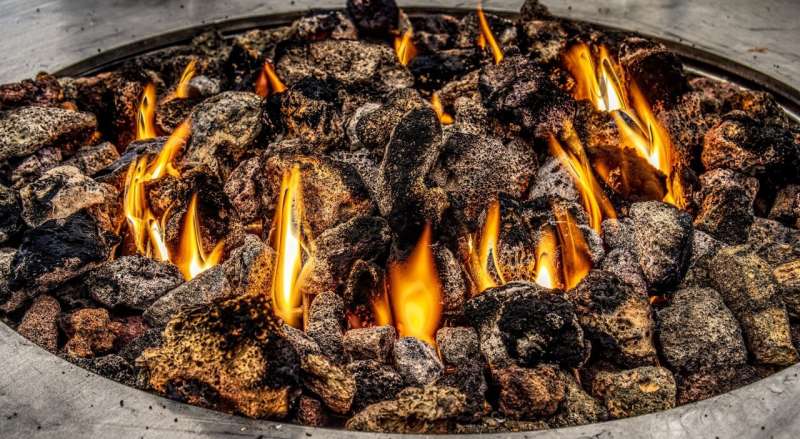This article has been reviewed according to Science X's editorial process and policies. Editors have highlighted the following attributes while ensuring the content's credibility:
fact-checked
peer-reviewed publication
trusted source
proofread
New study discovers a hidden culprit driving air pollution and climate change: Domestic firelighters

An international team of researchers from Ireland, China and India, led out of University of Galway, has exposed previously unrealized health and climate impacts from the use of domestic firelighters.
The research reveals that they are a previously unknown source of the powerful climate change driver black carbon. Their analysis also discovered that air quality and pollution levels in Dublin, Ireland have rivaled those in Beijing.
The research was published in npj Climate and Atmospheric Science. The study found that firelighters used to light open fires and stoves in the home—even if used in small quantities and for a short period of time—emit more black carbon than all biomass fuels put together.
Professor Jurgita Ovadnevaite, deputy director of the Ryan Institute Centre for Climate and Air Pollution Studies at University of Galway and coordinating scientist of the international research project, said, "Black carbon is one of the main pollutants that affect air quality, acting as a climate forcer or driver, second only to carbon dioxide. While the effect was revealed in Ireland, the impact of it is relevant to other European countries, the UK, and worldwide, especially now with a rebound in the use of solid fuel stoves due to the energy crisis."
The research team describe the impact of firelighter use in home heating and the release of black carbon as a significant and previously overlooked source of air pollution. Firelighters are kerosene-based and contain hydrocarbon alkane.
They noted that there are an estimated 70 million wood burning stoves, open fires and other solid fuel heating appliances in homes across Europe alone, while an EPA report from 2022 indicates an increase in the number of households switching to solid fuel fires, rather than a decline—a trend which may become more acute in the midst of the energy cost crisis.
Professor Jurgita Ovadnevaite added, "The potentially toxic particulate air pollutants, like black carbon, not only affect people's health but play a significant role in climate change and uncertainty of climate predictions. Unfortunately, there is no silver lining in this cloud over human health and climate change until the promotion of solid biomass fires and the use of firelighters for ignition is replaced by a co-benefit policy."
The analysis of air quality took place in south Dublin in 2016 and subsequent years, and included data recorded by the monitoring stations controlled by the EPA.
The research showed:
- In 2016, average black carbon levels in Dublin, supposedly a clean European city, rivaled those in Beijing. Data on concentrations showed disconcerting and comparable figures for black carbon in particulate matter—in Dublin: >7 micrograms of black carbon per cubic meter of air (μg m−3); in Beijing 5.5 μg m−3; and in Dehli: 15.9 μg m−3.
- More recent data from the AEROSOURCE network shows that black carbon concentrations in Dublin in winter 2022/23 are just below 1 μg m−3, while in Beijing it is on the order of 1-2.5 µg m−3.
- The mixture of pollutants emitted by kerosene-based firelighters and solid fuel burning results in a strong localized air heating effect, reducing the volume in which pollutants are dispersed (aka boundary layer height), further leading to high self-amplified air pollution levels.
- Black carbon, which is emitted by firelighters, and organic aerosol, which is produced by solid biomass burning, combine to result in a more powerful climate warming effect.
- Despite generally good air quality in Ireland thanks to Atlantic weather patterns, the AEROSOURCE research revealed that extreme air pollution events, spanning most populated areas across the country, occur frequently in wintertime and during these times concentrations of air pollutants exceed levels recommended for health.
- The research identified extraordinarily high concentrations of some particulate matter—classed as submicron—which are smaller than 1 micrometer.
The research team noted that air pollution is also the single biggest environmental health risk, causing more than 7 million premature deaths per year worldwide, according to the World Health Organization.
Dr. Chunshui Lin, a lead author of the paper who conducted the study while at University of Galway, said, "This study demonstrates how critical it is to augment regulatory air quality networks with sophisticated instrumentation that can provide information on air pollution sources and can identify the main air pollution culprits and reveal their effects on both air quality and climate."
Professor Colin O'Dowd, Director of the Ryan Institute Centre for Climate and Air Pollution Studies at University of Galway, said, "Compounds consisting of carbon are known to be diverse in source and nature resulting in more complex challenges in terms of understanding their contributions to air pollution and climate, and in determining their sources."
"Without this, effective pollution control and climate change mitigation strategies cannot be developed. However, these carbonaceous compounds are not routinely measured in regulatory air quality networks."
More information: Chunshui Lin et al, Air quality—climate forcing double whammy from domestic firelighters, npj Climate and Atmospheric Science (2023). DOI: 10.1038/s41612-023-00427-x
Journal information: npj Climate and Atmospheric Science
Provided by University of Galway




















